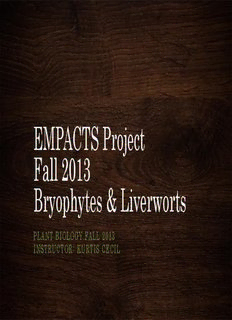
EMPACTS Project Fall 2013 Bryophytes & Liverworts PDF
Preview EMPACTS Project Fall 2013 Bryophytes & Liverworts
EMPACTS Project Fall 2013 Bryophytes & Liverworts PLANT BIOLOGY FALL 2013 INSTRUCTOR: KURTIS CECIL Group Members / Labor Andy Warren Jon Jacobs Brian Stine • Research • Research • Research • Field Work • Field Work • Slide preparation • Field Photography • Field Photography • Slide photography • Slide preparation • Slide preparation • GIS/Google Mapping • Slide photography • GIS/Google Mapping • Power point design • Benton County Liverwort Database Project Introduction The importance of this project is to begin the location, education and identification process of Bryophytes and Liverworts in the NWACC Nature Area Living Laboratory. Project Overview Educate on Locate samples Map the what a in the NWACC specimen with Taxonomy Bryophyte and Living GIS/Google Liverwort is Laboratory Earth Project Goals Our goals with this project is to learn more about the taxonomy and ecology of mosses and liverworts through research in the field as well as documentation. We would like to see future students build on what we have started through continued research and identification. Technology Used Leica ICC50 HD Microscope Garmin Handheld GPS unit Google Mapping Digital Camera Dissecting Scope Computer Software ― Word, Excel, Power point & Las EZ software for taking micro slide pictures. Educate What a Bryophyte is NOT! What a Bryophyte IS! • Pioneering plant • Spanish moss – produces flowers and seeds • Non vascular plants • Reindeer moss – lichen • Small herbaceous plants lacking leafy structure and • Photosynthetic phase life cycle color is the haploid, gametophyte • Irish moss – purplish generation. seaweed known as carrageen • Slow growth period • Grow closely packed together – Mats closely together Educate What a liverwort is: • Two distinct forms: • Leafy – Similar to mosses Easly distingused from mosses by their leaf arrangements. 2 – 3 rows while leaves in moss are spirally arranged. • Thalloid – Do not have leaves, instead the main body is flat. Easiest to identify. • Some Liverworts produce asexually. Educate Uses of Mosses: Bio indicators of air pollution ― Good indicators of acid rains to an ecosystem Erosion Control agents ― Moisture control ― Stability to soil Provides Nitrogen fixation in Sub Artic and Artic ecosystems Aesthetic purposes Educate Structures of Bryophytes
Description: